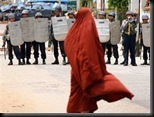Click here for photographs from Myanmar
The largest anti-government demonstrations in nearly two decades have thrust Myanmar into the international spotlight, but for many the core issues remain murky. Here are answers to some common questions:
What are the protests about?
The military government’s decision in August to hike fuel prices by more than double was the immediate cause of the Myanmar protests. The rallies initially were organized by pro-democracy activists, but Buddhist monks became involved after military authorities forcibly broke up a peaceful protest in early September.Who governs Myanmar?
The military has dominated the government for nearly half a century, but the generals have ruled with nearly absolute power since 1990, when the junta refused to hand over power after the main opposition party’s landslide electoral victory. President Bush has announced tighter new U.S. economic sanctions against Myanmar in addition to a pre-existing arms ban, a ban on exports, investment and financial services.Who are the monks leading the protests?
The Buddhist clergy historically has been politically influential in Myanmar, nearly 90 percent of which is Buddhist. The 400,000-500,000 Buddhist monks have wielded considerable spiritual and political clout among the citizens for centuries. The government has tried to win the support of senior clergy, with mixed success at best. The monks have been called Myanmar’s “saffron army.”Who is Aung San Suu Kyi?
Aung San Suu Kyi, 62, is the leader of Myanmar’s most prominent opposition group, the National League for Democracy, and the recipient of the 1991 Nobel Peace Prize. She has spent more than 11 of the past 18 years under some form of arrest under the country’s military regime. Her followers and other pro-democracy activists in the country are routinely harassed and imprisoned.
Is the country called Myanmar or Burma?
Both. The military regime changed the country’s name from Burma to Myanmar in 1989 after suppressing a popular uprising. The United Nations, France and Japan all accept the name Myanmar. But others, including Britain — the country’s former colonial ruler — and the United States, continue to use the name Burma under the rationale that the ruling junta has no democratic mandate. News organizations also differ: the British Broadcasting Corp. uses Burma, but The Associated Press and msnbc.com use Myanmar.To which branch of Buddhism do the monks adhere?
The Buddhists of Myanmar observe the Theravada school, which is typically found in south and southeast Asia. The Theravada school focuses on personal liberation from craving and suffering.Where and how big is Myanmar?
Myanmar is located in south-southeastern Asia, bordering the Andaman Sea and the Bay of Bengal. Bangladesh borders Myanmar to the west, China to the north and west, and Laos and Thailand to the east. It is around 421,000 square miles, or slightly smaller than the state of Texas. Nearly 50 million people live in the country.
Q&A: Myanmar protests backgrounder - Asia-Pacific - MSNBC.com


No comments:
Post a Comment